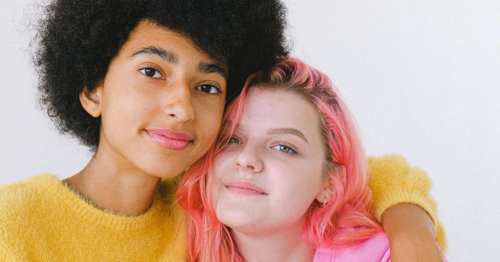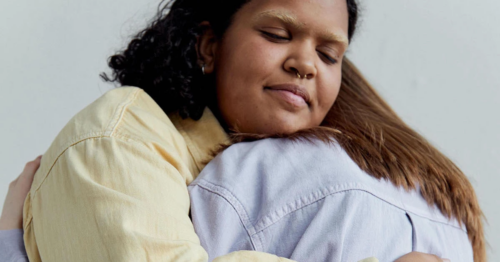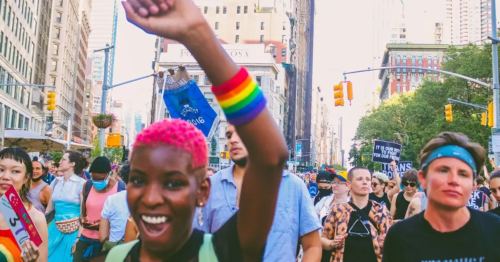
Table of Contents
Gender vs. Sexuality: What’s the Difference?
Written By: Charlie Health Editorial Team

Clinically Reviewed By: Dr. Don Gasparini
June 28, 2023
8 min.
In short, gender is about who someone is, whereas sexuality is about who they are attracted two. Learn more about these two facets of human identity here.
Learn more about our Clinical Review Process
Table of Contents
What’s the difference between gender and sexuality?
Gender and sexuality are two separate parts of human identity. In short, gender is about who someone is, whereas sexuality is about who they are attracted to.
Gender defined
Gender refers to the social and cultural roles, expectations, and identities that society expects of someone based on their assigned sex — usually male or female. It encompasses a range of behaviors, expressions, and identities. For example, gender is influenced by society’s ideas and beliefs about how men and women should act, dress, and communicate. These expectations dictate how individuals are supposed to conform to certain gender roles and norms.
Sexuality defined
Sexuality is about who a person is attracted to emotionally, romantically, and sexually. It is a deeply personal and individual aspect of identity that can be independent of gender identity. While gender identity pertains to how individuals perceive themselves in relation to societal gender expectations, sexuality concerns the nature of their attractions and desires.
Both gender and sexuality are associated with many different identities, which we will define below. Understanding the distinction between gender and sexuality is crucial for promoting inclusivity, respect, and acceptance for all people.
Definitions of different gender identities
Here are definitions of some different gender identities:
Cisgender
People whose gender identity aligns with the sex they were assigned at birth. For example, someone who was assigned female at birth and identifies as a woman is cisgender.
Transgender
People whose gender identity differs from the sex they were assigned at birth. For instance, a person who was assigned male at birth but identifies as a woman is transgender. Transgender people may undergo gender-affirming medical interventions, such as hormone therapy or surgery, to align their physical appearance with their gender identity.
Nonbinary
This is an umbrella term for gender identities that do not exclusively fit within the categories of male or female. Nonbinary people may identify as a mix of genders, outside of the gender binary, or as having no gender at all. They may use various terms to describe their gender identity, such as genderqueer, genderfluid, or agender.
Genderqueer
People who reject or challenge traditional binary notions of gender. They may identify as a combination of genders or as neither exclusively male nor female.
Genderfluid
People who have a gender identity that is not fixed and may change over time. Their gender identity can fluctuate between different genders along the gender spectrum.
Agender
People who do not identify with any gender or do not have a sense of gender. They may feel a lack of gender or disconnect from the concept of gender altogether.
Gender identities are diverse and can vary from person to person. These definitions are not exhaustive, and individuals may use different terms or identify in ways unique to their experiences and self-understanding.

Virtual LGBTQIA+-affirming care.
Personalized therapy that fits your unique needs.
Definitions of different sexual orientations
Here are definitions of some different sexual orientations:
Heterosexual
People who are primarily emotionally, romantically, and sexually attracted to individuals of the opposite gender, also commonly referred to as straight. For example, women who are attracted to men or men who are attracted to women often call themselves straight or heterosexual.
Homosexual
People who are primarily emotionally, romantically, and sexually attracted to individuals of the same gender, also often known as gay. Some gay women may prefer the term lesbian.
Bisexual
People who are emotionally, romantically, and sexually attracted to people of their gender and other genders. Bisexuality specifically encompasses attraction to both men and women.
Pansexual
People who are emotionally, romantically, and sexually attracted to people across many different gender identities. Pansexuality recognizes that attraction can transcend the gender binary and includes a spectrum of genders.
Queer
Like pansexual, queer refers to people whose emotional, romantic, and sexual attraction encompasses a range of gender identities. Queer is often used by people who feel their sexual orientation isn’t captured by other labels—typically defined by heterosexual and cisgender norms—or who reject labels altogether.
Asexual
People who experience little to no sexual attraction towards others. They may still experience romantic or emotional attraction and engage in intimate relationships.
These definitions provide a general understanding of various sexual orientations, but sexual orientation—like gender identity—is a personal and individual aspect of identity. It can be fluid and may be experienced and expressed in unique ways by different people.
Discrimination based on gender and sexuality
Unfortunately, many people experience unfair or unequal treatment based on their gender identity or sexual orientation. This kind of discrimination can occur on an interpersonal level, involving acts of unfair treatment, bias, or prejudice between people, or on a systemic level, where discrimination is embedded within social, cultural, and institutional systems.
Experiences of discrimination are complex and intersectional, meaning that individuals who belong to multiple marginalized groups may face compounded forms of discrimination and oppression. For example, research shows that discriminatory actions against transgender rights — which have worsened in recent years — disproportionately impact transgender people who are also Black, Indigenous, and People of Color (BIPOC).

Gender-based discrimination
Gender-based discrimination can occur in many different spheres of life, highlighting the importance of addressing these issues and striving for gender equity. Here are some examples of gender-based discrimination:
- Gender pay gap: Studies consistently show that, on average, women earn less than men for performing the same work or work of equal value, indicating unequal opportunities and biased compensation practices. The gap tends to be wider for women of color, women with disabilities, and women from lower socioeconomic backgrounds.
- Occupational segregation: The concentration of people from a particular gender in specific industries or job roles. For example, women are often underrepresented in fields such as science, technology, engineering, and mathematics (STEM), while men are underrepresented in fields such as nursing and early childhood education. This segregation limits individuals’ employment choices on the basis of gender and perpetuates gender-based stereotypes and disparities.
- Parental leave and work-life balance: Gender disparities in parental leave policies and societal expectations around caregiving contribute to systemic discrimination. The burden of childcare responsibilities often falls disproportionately on women, impacting their career progression and perpetuating gender inequalities in the workplace.
- Unequal access to education: In some regions, girls and women face barriers to education, such as restricted access to schooling, gender-based violence in educational settings, or cultural beliefs that prioritize boys’ education over girls’. Denying education to girls and women perpetuates gender inequalities and restricts their opportunities for personal and professional development.
- Gender-based violence: Domestic violence, sexual assault, and harassment, disproportionately affect women—especially women from marginalized backgrounds—and perpetuate power imbalances, reinforcing gender inequalities.
- Reproductive rights and healthcare: This includes restrictions or inadequate access to reproductive healthcare and services, like contraception, abortion, and pregnancy care. Limiting peoples’ control over their reproductive health impacts their autonomy, well-being, and ability to participate fully in society. Limiting access to gender-affirming care, such as hormone replacement therapy, for transgender people is another example of gender-based healthcare discrimination.
- Legal discrimination: Discriminatory laws or policies that perpetuate gender-based inequalities represent systemic discrimination. Examples include laws that restrict women’s inheritance rights, deny equal property ownership, or impose gender-based dress codes.
- Gender conversion therapy: A harmful and discredited practice that aims to change or suppress a transgender or gender-diverse person’s gender identity. This practice has been widely discredited and condemned by professional medical and mental health organizations due to their lack of scientific basis, potential for psychological harm, and violation of individuals’ rights to self-determination and gender expression.
Join the Charlie Health Library
Get mental health updates, research, insights, and resources directly to your inbox.
You can unsubscribe anytime.
Sexuality-based discrimination
LGBTQIA+ people are most often the targets of sexuality-based discrimination which, like gender-based discrimination, can occur in many spheres of life. Advocating for LGBTQIA+ legal protections, promoting inclusive policies, and fostering acceptance and understanding of LGBTQIA+ people are crucial steps toward combating systemic discrimination based on sexual orientation. Here are some examples of gender-based discrimination:
- Employment discrimination: LGBTQIA+ people face discrimination in the workplace, including being denied job opportunities, experiencing biased hiring or promotion practices, or facing harassment or termination based on their sexual orientation.
- Housing discrimination: Sexuality-based housing discrimination happens when people are denied access to housing or subjected to unfair treatment based on their sexual orientation. This can include refusal to rent or sell properties to LGBTQIA+ people, discriminatory rental terms, or harassment from landlords or neighbors due to someone's sexual orientation.
- Legal discrimination: Laws that explicitly or implicitly discriminate against LGBTQIA+ individuals based on their sexual orientation. Examples include the criminalization of consensual same-sex relationships, lack of legal recognition of same-sex partnerships or marriages, and restrictions on adoption or parenting rights for LGBTQIA+ people.
- Healthcare disparities: In many healthcare settings LGBTQIA+ people face barriers to accessing quality and culturally competent care. This can include denial of treatment, inadequate training for healthcare providers on LGBTQIA+ health needs, or discriminatory practices that affect mental health, reproductive healthcare, or HIV/AIDS care.
- Bullying and harassment in schools: LGBTQIA+ youth often experience discrimination in educational settings, including bullying, harassment, and exclusion based on their sexual orientation. Inadequate policies and a lack of inclusive curricula contribute to an unwelcoming and unsafe environment for LGBTQIA+ students.
- Violence and hate crimes: Acts of violence and hate crimes targeted at individuals based on their sexual orientation. LGBTQIA+ individuals may face physical assault, verbal abuse, or even murder due to their sexual orientation.
- Limited representation and media portrayals: The erasure or negative portrayal of LGBTQIA+ people in media, entertainment, and public spheres perpetuates stigma, stereotypes, and marginalization.
- Sexuality conversion therapy: A harmful and discredited practice that aims to change or suppress an LGBTQIA+ person’s sexual orientation. This practice lacks scientific validity and can cause severe emotional and psychological distress and perpetuate stigma and discrimination against LGBTQIA+ individuals.
The impacts of discrimination based on gender and sexuality
Gender- and sexuality-based discrimination have profound impacts on people and communities. Discrimination based on gender and sexuality can lead to significant psychological harm, including increased rates of depression, anxiety, and self-esteem issues among those who experience it. These kinds of discrimination isolate marginalized people—including women, girls, gender-diverse and LGBTQIA+ people—denying them equal access to employment, education, healthcare, housing, and other resources. Gender- and sexuality-based discrimination perpetuates inequalities and hinders personal and professional growth, contributing to economic disparities. Both forms of discrimination also increase the risk of violence and harassment against marginalized people, compromising their safety and well-being.
The effects ripple beyond individuals, impacting relationships, families, and communities. Moreover, discrimination limits self-expression and constrains the exploration of diverse identities, hindering personal growth and authentic self-discovery. It is essential to address and dismantle these forms of discrimination to foster inclusive and equitable societies that respect and value the dignity of all individuals, regardless of their gender identity or sexual orientation.
Exploring gender and sexuality at Charlie Health
Charlie Health is committed to serving people of all genders and sexualities in a safe, compassionate, and empowering environment. Our culturally-competent mental health professionals are here to listen to your story, understand your needs, and match you with an appropriate treatment plan.
Charlie Health’s personalized virtual Intensive Outpatient Program (IOP) offers mental health treatment for teens, young adults, and families who are dealing with a variety of mental health struggles, and we have specific support for people exploring their gender and sexuality. Get started today.
References
https://www.nih.gov/nih-style-guide/sex-gender-sexuality
https://www.cdc.gov/healthyyouth/terminology/sexual-and-gender-identity-terms.htm
https://www.apa.org/topics/lgbtq
https://www.cdc.gov/tobacco/health-equity/lgbtq/unfair-and-unjust.html
https://www.ncbi.nlm.nih.gov/pmc/articles/PMC8986269/
https://www.aclu.org/legislative-attacks-on-lgbtq-rights-2024




